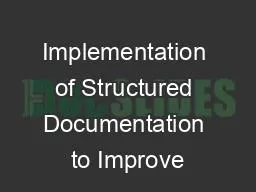

Adherence to Clinical Guidelines Emily Manlove MD 1 Tara Neil MD 2 Rachel Griffith DO 2 Mary Masterman MD 2 Michelle Baalmann MD 2 Stephanie Shirey MS2 3 ID: 780265
Download The PPT/PDF document "Implementation of Structured Documentati..." is the property of its rightful owner. Permission is granted to download and print the materials on this web site for personal, non-commercial use only, and to display it on your personal computer provided you do not modify the materials and that you retain all copyright notices contained in the materials. By downloading content from our website, you accept the terms of this agreement.
Slide1
Implementation of Structured Documentation to Improve
Adherence to
Clinical Guidelines
Emily Manlove, MD1; Tara Neil, MD2; Rachel Griffith, DO2; Mary Masterman, MD2; Michelle Baalmann, MD2; Stephanie Shirey, MS23 ; Kieu Pham4; Marilyn Nguyen4; Samuel Ofei-Dodoo, Ph.D1.1KUSM-W DFCM, 2KUSM-W DFM at Via Christi Hospitals, 3KUSM-W, 4Wichita State University
INTRODUCTION
In Electronic Health Records, premade templates may improve performance or quality measures.
Without templates, screening and complicated disease, such as pre-eclampsia, may be undertreated.
In March of 2017 Via Christi Family Medicine Residency Clinic (VCFMRC) implemented a “dot phrase” to function as structured documentation for initial obstetrical (IOB) visits.This structured template served as a prompt for the physician to address the specific risk factors for pre-eclampsia at the initial pregnancy visit.Our study aims to evaluate the utility of structured templates to improve compliance with clinical guidelines.METHODSApproachRisk factors, past medical history, family medical history, and the gestational age in conjunction with the method that determines it were extracted from patient chartsA pre-intervention analysis was compared to a post-intervention (template added) analysis.Special attention was paid to whether or not the physician recommended aspirin therapy in the setting of risk factors for A total of 205 charts were reviewed.AnalysisFrequency distributions were calculated to examine the number of OB patients who were at risk for pre-eclampsia and the number of those who received aspirin recommendation based on their determined risks. Cumulative risk, rate ratio, and percentage relative effect were calculated to assess for improved compliance.
RESULTSThe increase in compliance with guidelines with the use of the structured template was 324% [95% CI = 2.9, 3.1]
DISCUSSIONResidents were not adequately screening before the intervention was done (17% treatment rate)The OB template greatly improved treatment rate (79% treatment rate)A template can act as a checklist or a reminder in a complicated visit or encounters that require many tasks to be performed Structured documentation improves compliance with pre-eclampsia risk evaluation and treatment and may also improve compliance with other clinical guidelines.CONCLUSION Utility of the updated IOB structured documentation provided strong evidence as an effective prompt for physicians to appropriately recommend aspirin. Study LimitationsPost-implementation, documentation of preeclampsia risk was not standard as some residents deleted this section for patients with low risk factorsUnable to assess whether residents actually asked patients regarding risk factors (trusting documentation)Some residents may have assessed aspirin risk on second or another OB visit (not first)Some residents may have assessed risk and prescribed aspirin but not documented this in noteFuture StudiesAssessment of actual aspirin prescribing practices and filling by patients.Measure clinical outcomes (e.g., rate of preeclampsia in patients before vs after implementation of template)Longitudinal study measuring results before, after, and 3 months after intervention. This would help evaluate the effect and "dose response" of the dot phrase.
Table 2Percent relative effect of OB dot phrase on Aspirin recommendation for patients at risk of pre-eclampsiaRisk of Pre-eclampsia?Aspirin Recommendation Pre-structured document Post-structured document Yes1134No/not documented 489Total59 43Cumulative risk18.64%79.07%Rate Ratio4.24% Relative effect 324% (4.24 - 1)95% Confidence Interval[2.9, 3.1]
Table 1
Descriptive statistics of patients who were at risk of pre-eclampsia and aspirin recommendation
Pre-structured document
Post-structured document
Risk of pre-eclampsia?
Aspirin recommended?
Risk of pre-eclampsia?
Aspirin recommended?
#
%
#
%
#
%
#
%
Yes
59
57.3
11
18.6
43
42.2
34
79.1
No
44
42.7
1
1.7
59
57.8
8
18.6
Not documented
0
0
47
79.7
0
0
1
2.3
Total
103
100
59
100
102
100
43
100